[English] 日本語
 Yorodumi
Yorodumi- EMDB-7448: 3.6-angstrom resolution cryo-EM density map of the Alternative Co... -
+ Open data
Open data
- Basic information
Basic information
| Entry | Database: EMDB / ID: EMD-7448 | |||||||||
|---|---|---|---|---|---|---|---|---|---|---|
| Title | 3.6-angstrom resolution cryo-EM density map of the Alternative Complex III from Flavobacterium johnsoniae (Wild Type) | |||||||||
 Map data Map data | 3.6-angstrom map for the Alternative Complex III from Flavobacterium johnsoniae | |||||||||
 Sample Sample |
| |||||||||
| Biological species |  Flavobacterium johnsoniae UW101 (bacteria) Flavobacterium johnsoniae UW101 (bacteria) | |||||||||
| Method | single particle reconstruction / cryo EM / Resolution: 3.6 Å | |||||||||
 Authors Authors | Benlekbir S / Rubinstein JL | |||||||||
 Citation Citation |  Journal: Nature / Year: 2018 Journal: Nature / Year: 2018Title: Structure of the alternative complex III in a supercomplex with cytochrome oxidase. Authors: Chang Sun / Samir Benlekbir / Padmaja Venkatakrishnan / Yuhang Wang / Sangjin Hong / Jonathan Hosler / Emad Tajkhorshid / John L Rubinstein / Robert B Gennis /   Abstract: Alternative complex III (ACIII) is a key component of the respiratory and/or photosynthetic electron transport chains of many bacteria. Like complex III (also known as the bc complex), ACIII ...Alternative complex III (ACIII) is a key component of the respiratory and/or photosynthetic electron transport chains of many bacteria. Like complex III (also known as the bc complex), ACIII catalyses the oxidation of membrane-bound quinol and the reduction of cytochrome c or an equivalent electron carrier. However, the two complexes have no structural similarity. Although ACIII has eluded structural characterization, several of its subunits are known to be homologous to members of the complex iron-sulfur molybdoenzyme (CISM) superfamily , including the proton pump polysulfide reductase. We isolated the ACIII from Flavobacterium johnsoniae with native lipids using styrene maleic acid copolymer, both as an independent enzyme and as a functional 1:1 supercomplex with an aa-type cytochrome c oxidase (cyt aa). We determined the structure of ACIII to 3.4 Å resolution by cryo-electron microscopy and constructed an atomic model for its six subunits. The structure, which contains a [3Fe-4S] cluster, a [4Fe-4S] cluster and six haem c units, shows that ACIII uses known elements from other electron transport complexes arranged in a previously unknown manner. Modelling of the cyt aa component of the supercomplex revealed that it is structurally modified to facilitate association with ACIII, illustrating the importance of the supercomplex in this electron transport chain. The structure also resolves two of the subunits of ACIII that are anchored to the lipid bilayer with N-terminal triacylated cysteine residues, an important post-translational modification found in numerous prokaryotic membrane proteins that has not previously been observed structurally in a lipid bilayer. | |||||||||
| History |
|
- Structure visualization
Structure visualization
| Movie |
 Movie viewer Movie viewer |
|---|---|
| Structure viewer | EM map:  SurfView SurfView Molmil Molmil Jmol/JSmol Jmol/JSmol |
| Supplemental images |
- Downloads & links
Downloads & links
-EMDB archive
| Map data |  emd_7448.map.gz emd_7448.map.gz | 59.6 MB |  EMDB map data format EMDB map data format | |
|---|---|---|---|---|
| Header (meta data) |  emd-7448-v30.xml emd-7448-v30.xml emd-7448.xml emd-7448.xml | 10.7 KB 10.7 KB | Display Display |  EMDB header EMDB header |
| Images |  emd_7448.png emd_7448.png | 71.6 KB | ||
| Archive directory |  http://ftp.pdbj.org/pub/emdb/structures/EMD-7448 http://ftp.pdbj.org/pub/emdb/structures/EMD-7448 ftp://ftp.pdbj.org/pub/emdb/structures/EMD-7448 ftp://ftp.pdbj.org/pub/emdb/structures/EMD-7448 | HTTPS FTP |
-Validation report
| Summary document |  emd_7448_validation.pdf.gz emd_7448_validation.pdf.gz | 78.3 KB | Display |  EMDB validaton report EMDB validaton report |
|---|---|---|---|---|
| Full document |  emd_7448_full_validation.pdf.gz emd_7448_full_validation.pdf.gz | 77.4 KB | Display | |
| Data in XML |  emd_7448_validation.xml.gz emd_7448_validation.xml.gz | 493 B | Display | |
| Arichive directory |  https://ftp.pdbj.org/pub/emdb/validation_reports/EMD-7448 https://ftp.pdbj.org/pub/emdb/validation_reports/EMD-7448 ftp://ftp.pdbj.org/pub/emdb/validation_reports/EMD-7448 ftp://ftp.pdbj.org/pub/emdb/validation_reports/EMD-7448 | HTTPS FTP |
-Related structure data
- Links
Links
| EMDB pages |  EMDB (EBI/PDBe) / EMDB (EBI/PDBe) /  EMDataResource EMDataResource |
|---|
- Map
Map
| File |  Download / File: emd_7448.map.gz / Format: CCP4 / Size: 64 MB / Type: IMAGE STORED AS FLOATING POINT NUMBER (4 BYTES) Download / File: emd_7448.map.gz / Format: CCP4 / Size: 64 MB / Type: IMAGE STORED AS FLOATING POINT NUMBER (4 BYTES) | ||||||||||||||||||||||||||||||||||||||||||||||||||||||||||||||||||||
|---|---|---|---|---|---|---|---|---|---|---|---|---|---|---|---|---|---|---|---|---|---|---|---|---|---|---|---|---|---|---|---|---|---|---|---|---|---|---|---|---|---|---|---|---|---|---|---|---|---|---|---|---|---|---|---|---|---|---|---|---|---|---|---|---|---|---|---|---|---|
| Annotation | 3.6-angstrom map for the Alternative Complex III from Flavobacterium johnsoniae | ||||||||||||||||||||||||||||||||||||||||||||||||||||||||||||||||||||
| Projections & slices | Image control
Images are generated by Spider. | ||||||||||||||||||||||||||||||||||||||||||||||||||||||||||||||||||||
| Voxel size | X=Y=Z: 1.1 Å | ||||||||||||||||||||||||||||||||||||||||||||||||||||||||||||||||||||
| Density |
| ||||||||||||||||||||||||||||||||||||||||||||||||||||||||||||||||||||
| Symmetry | Space group: 1 | ||||||||||||||||||||||||||||||||||||||||||||||||||||||||||||||||||||
| Details | EMDB XML:
CCP4 map header:
| ||||||||||||||||||||||||||||||||||||||||||||||||||||||||||||||||||||
-Supplemental data
- Sample components
Sample components
-Entire : ACIII-cyt aa3 supercomplex
| Entire | Name: ACIII-cyt aa3 supercomplex |
|---|---|
| Components |
|
-Supramolecule #1: ACIII-cyt aa3 supercomplex
| Supramolecule | Name: ACIII-cyt aa3 supercomplex / type: complex / ID: 1 / Parent: 0 / Macromolecule list: #1-#6 Details: Alternative complex III-- cytochrome aa3 oxidase supercomplex purified with styrene maleic acid copolymer |
|---|---|
| Source (natural) | Organism:  Flavobacterium johnsoniae UW101 (bacteria) Flavobacterium johnsoniae UW101 (bacteria) |
-Experimental details
-Structure determination
| Method | cryo EM |
|---|---|
 Processing Processing | single particle reconstruction |
| Aggregation state | particle |
- Sample preparation
Sample preparation
| Concentration | 3 mg/mL |
|---|---|
| Buffer | pH: 8 |
| Grid | Material: GOLD |
| Vitrification | Cryogen name: ETHANE-PROPANE |
- Electron microscopy
Electron microscopy
| Microscope | FEI TITAN KRIOS |
|---|---|
| Image recording | Film or detector model: GATAN K2 SUMMIT (4k x 4k) / Detector mode: COUNTING / Digitization - Dimensions - Width: 3838 pixel / Digitization - Dimensions - Height: 3710 pixel / Digitization - Frames/image: 1-40 / Number grids imaged: 2 / Number real images: 2017 / Average exposure time: 10.0 sec. / Average electron dose: 61.0 e/Å2 |
| Electron beam | Acceleration voltage: 300 kV / Electron source:  FIELD EMISSION GUN FIELD EMISSION GUN |
| Electron optics | Illumination mode: FLOOD BEAM / Imaging mode: BRIGHT FIELD |
| Experimental equipment |  Model: Titan Krios / Image courtesy: FEI Company |
+ Image processing
Image processing
-Atomic model buiding 1
| Refinement | Space: REAL / Protocol: OTHER |
|---|
 Movie
Movie Controller
Controller


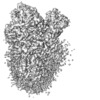




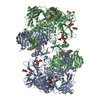

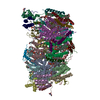
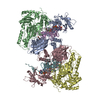
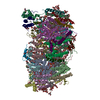
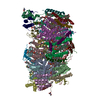
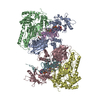
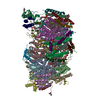

 Z (Sec.)
Z (Sec.) Y (Row.)
Y (Row.) X (Col.)
X (Col.)





















